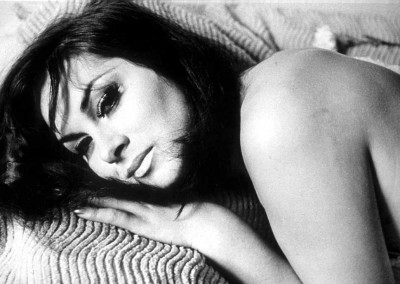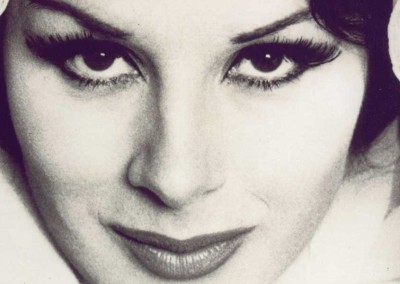In One-Man Show, Michael Schreiber chronicles the storied life, illustrious friends and lovers, and astounding adventures of Bernard Perlin through no-holds-barred interviews with the artist, candid excerpts from Perlin’s unpublished…..

April Ashley
April Ashley
Text & photos Courtesy of National museums Liverpool
Born in Liverpool in 1935, April Ashley, a former Vogue model and actress was one of the first people in the world to undergo pioneering gender reassignment surgery. As one of the most famous transgender individuals and a tireless campaigner for transgender equality, she is an icon and inspiration to many. For the first time, the Museum of Liverpool explores April’s very public story through her previously unseen private archive and investigate the wider impact of changing social and legal conditions for all trans and lesbian, gay and bisexual people from 1935 to today.
Childhood
April Ashley was born George Jamieson, one of six children to Frederick, who served in the Royal Navy, and Ada, a factory worker. The family’s poor living conditions meant they were soon moved by Liverpool Corporation from Pitt Street, in the Chinatown area, to Norris Green. Although born a boy, April always felt and looked like a girl. Childhood was a lonely and very confusing time. At St Teresa’s primary school she was bullied for being different. As a teenager April did not grow facial hair, her voice refused to break and she began to develop breasts.
Identity
Aged 15, April joined the Merchant Navy as ‘I decided to face up to my situation and it seemed to be one of the things that made you a man’. Feeling and looking different in this very masculine environment, however, was very challenging. Whilst on leave in America, and seeing no way out, she attempted suicide in 1952. After recovering she was given a dishonorable discharge. Back in Liverpool, April continued to struggle alone with her gender identity and in 1953 made another attempt to take her own life by jumping into the River Mersey. She was sent to Ormskirk Hospital psychiatric unit and later treated at Walton Hospital. Her care was brutal and included sodium pentothal injections and electro convulsive treatment followed by a course of male hormones. The experiences were devastating and had a detrimental effect on April’s health and well being. In 1955, aged 20, April decided to leave Liverpool for London. In London April worked at a Lyons Corner House, a bustling cafe and informal, underground meeting point for artists, bohemians and gay men. Being gay or trans was a precarious and illegal life. Homosexuality was not decriminalized until 1967 and trans and gay people faced much discrimination. Being in London gave April anonymity and the freedom to accept and reveal her true identity. In this supportive environment and with other trans role models around her, she began to call herself ‘Toni’ and wear female clothes and make-up. It was here in 1956 that she made an invaluable connection that was to take her to Paris and the world famous Carrousel club.
Le Carrousel
Le Carrousel de Paris was renowned for its spectacular performances by male and female impersonators, which attracted stars such as Ginger Rogers, Claudette Colbert, Marlene Dietrich and Rex Harrison. In stark contrast to post-war England, Paris represented a sexual liberalism, freedom and openness that was previously unimaginable to young April. She was soon employed at the club and paid £12 per week. Assuming a new identity and using the theatrical name of ‘Toni April’, she performed alongside famous female impersonators, Coccinelle, Bambi and Peki d’Oslo. Her confidante and closest friend Bambi introduced her to a Parisian doctor who prescribed the female hormone estrogen which further assisted April’s feminization. April was soon touring with Le Carrousel across Europe. Whilst in Milan she visited the British Consulate to attempt to change the name on her passport from George Jamieson to ‘Toni April’ but was met with hostility. Throughout her life April had recognized that she wasn’t a boy and knew that she could not be ‘cured’ through therapy, medication or psychiatry. She longed to become the woman she felt she had always been. Working at Le Carrousel she had saved enough money to attempt to make this wish come true. Her friend Coccinelle suggested she contact Dr George Burou, a pioneer in gender re-assignment surgery who was based in Casablanca, Morocco. She left for Casablanca on 12 May 1960 and within three days of arriving the correction of her genitalia from male to female was complete. She was the ninth patient on which Dr Burou had performed the surgery. It was a complex but successful operation. As a consequence her hair fell out and she endured significant pain, but April had finally become the woman she had always believed she was. She told Dr Burou that it was ‘the happiest day of my life’.
High profile career
Following gender reassignment surgery in 1960 April returned to London and changed her name to ‘April Ashley’ by deed poll. With her statuesque good looks and newfound confidence she became a fashion model and actress. She was photographed for high profile publications such as Vogue and socialized with famous musicians, actors and members of London’s high society. In 1961 April met and began an affair with Arthur Corbett, an Eton-educated aristocrat. Corbett had frequented Le Carrousel and was fully aware of April’s history and gender re-assignment. Corbett left his wife and four children to begin a relationship with April.
‘Following gender reassignment surgery in 1960 she returned to London and changed her name to ‘April Ashley’ by deed poll.’
Outing
On Sunday November 19th, 1961 April Ashley was outed as a transsexual in the Sunday People newspaper, prompting numerous other headlines around the world. The press coverage of April’s gender transition was hostile and transphobic, portraying her in an inhuman way. April was humiliated and shocked by the unexpected revelations. Her modeling assignments soon stopped.
Marriage
In 1963 April married Arthur Corbett in Gibraltar, but the relationship soon broke down and April returned to London. Corbett petitioned for divorce in 1967 using the grounds that April was born male and therefore the marriage was illegal. The medical and legal position on transsexuality was divided, no consensus on whether a person could legally change gender could be reached and it was left to the divorce court to decide. This proved to be a test case, which continues to have implications for people throughout the world today.
Corbett vs Corbett
In February 1970 the case of Corbett vs Corbett was heard and became universally known as the divorce case which set a legal precedent regarding the status of transsexuals in the whole country. The judge Lord Justice Ormrod, created a medical ‘test’ and definition to determine the legal status of April, and by extension, all transsexual people. This was a huge personal setback to April, who suffered intrusive tests and more derogatory press attention. The judge ruled in February 1971 that ‘she was male’ and the marriage was annulled. This ruling became a legal precedent used to define the gender of transsexual people for decades. The legal status of transgender people has only been fully recognized since the introduction of the Gender Recognition Act 2004. In the 1990s and early 2000s April continued her campaign to have her true gender recognized. She lobbied and wrote to Prime Minister Tony Blair and the Lord Chancellor, remaining resolutely committed to changing the law for all transgender people. In 2005, after the passage of the Gender Recognition Act 2004, April was finally legally recognized as female and issued with a new birth certificate. The then Deputy Prime Minister, John Prescott, who had previously worked with April in the 1950s, helped her with the procedure. In 2012 she was appointed a Member of the Order of the British Empire (MBE) for services to transgender equality and continues to be an inspiration to many today.
A collaborative project between the Museum of Liverpool and Homotopia – the international festival of queer arts and culture. This exhibition is supported by the Heritage Lottery Fund. It was a key part of Homotopia’s 10th anniversary in 2013.
Related articles
Bernard Perlin
The Cockettes
As the psychedelic San Francisco of the ’60’s began evolving into the gay San Francisco of the ’70’s, The Cockettes, a flamboyant ensemble of hippies decked themselves out in gender-bending drag and tons of glitter for a series of legendary midnight…..
Our Hands On Each Other
Our Hands On Each Other is a multi-disciplinary artwork by New York based artist and historian Leah DeVun. A project consisting of photographs, performances and conversations centered around queer and feminist space. To document rural…..
Billy, the world’s first out and proud gay doll
To celebrate and document their conceptual artwork Billy, also known as Billy – The World’s First Out and Proud Gay Doll, artists John McKitterick and Juan Andres have launched a new website. In the highly politically and emotionally charged atmosphere…..
April Ashley
Born in Liverpool in 1935, April Ashley, a former Vogue model and actress was one of the first people in the world to undergo pioneering gender reassignment surgery. As one of the most famous transgender individuals and a tireless campaigner for…..
Bob Mizer & Tom of Finland
The Museum of Contemporary Art, Los Angeles (MOCA) presents Bob Mizer & Tom of Finland, the first American museum exhibition devoted to the art of Bob Mizer (1922–1992) and Touko Laaksonen, aka ‘Tom of Finland’ (1920–1991), two of…..
New Club Kids
The Noughties saw the rise of a new generation of Club Kids following in the footsteps of their predecessors – the original Club Kids of New York City, who, in turn, had followed London’s Blitz generation. In the early 1980’s, the Blitz Club in London’s…..












